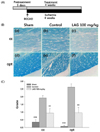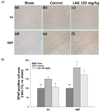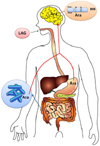Abstract
BACKGROUND/OBJECTIVES
MATERIALS/METHODS
RESULTS
Figures and Tables
 | Fig. 1A schematic diagram of the visual and pupillary light reflex (PLR) pathways.In the visual pathway, visual information reaching the retina passes through the optic nerve, optic tract (opt), and lateral geniculate nucleus (LGN) to the primary visual cortex (V1). In the PLR pathway, information for light intensity is mediated from the retina through the optic nerve, opt, pretectal nucleus, and oculomotor nerve to the pupillae muscle [22]. opt, optic tract.
|
 | Fig. 2Luxol fast blue staining of myelin.(A). Experimental Scheme. LAG (100 mg/kg/day) was supplemented for 5 days before the rats underwent BCCAO surgery, and supplementation continued for another 4 weeks after surgery. In BCCAO surgery, the bilateral common carotid arteries in the control and LAG-treated groups were exposed and ligated permanently with silk sutures. The rats in the sham group underwent the same experimental procedure without ligation. The rats were then anesthetized again via isoflurane inhalation, after which their brains were harvested for Luxol fast blue staining and immunohistochemical staining. (B). Representative photomicrographs of selected white matter regions stained with Luxol fast blue (200×): (a), (d) sham group; (b), (e) control group; (c), (f) LAG-treated group; (a)–(c) and (d)–(f) were taken from the cc and opt, respectively. (C). Quantitative analysis of white matter injury. The extent of white matter injury in the cc and opt were graded as normal (Grade 0), disarrangement of nerve fibers (Grade 1), formation of marked vacuoles (Grade 2), and loss of myelinated fibers (Grade 3). The numbers of rats used in the sham, control and LAG-treated groups were 6, 6 and 6, respectively. ***P < 0.001, **P < 0.01 vs. control group. LAG, larch arabinogalactan; BCCAO, bilateral common carotid artery occlusion; cc, corpus callosum; opt, optic tract.
|
 | Fig. 3Immunochemical staining of astrocytes.(A). Representative photomicrographs of astrocytes stained against GFAP with immunochemical techniques (100×): (a), (d) sham group; (b), (e) control group; (c), (f) LAG-treated group; (a)–(c) and (d)–(f) were taken from the cc and opt, respectively. (B). Quantitative analysis of GFAP-positive cells. The relative areas of GFAP-positive cells in the cc and opt were presented by setting the area of GFAP-positive cells for the sham group to 100%. The numbers of rats used in the sham, control and LAG-treated groups were 6, 6 and 6, respectively. **P < 0.01, *P < 0.05 vs. control group. GFAP, glial fibrillary acidic protein; LAG, larch arabinogalactan.
|
 | Fig. 4Immunochemical staining of microglia.(A). Representative photomicrographs of microglia stained against Iba1 with immunochemical techniques (200×): (a) sham group; (b) control group; (c) LAG-treated group; (a)–(c) were taken from the opt. (B). Quantitative analysis of Iba1-positive cells. The relative numbers of Iba1-positive cells in the opt were presented by setting the number of Iba1-positive cells for the sham group at 100%. The numbers of rats used in the sham, control and LAG-treated groups were 6, 6 and 6, respectively. ***P < 0.001, **P < 0.01 vs. control group. LAG, larch arabinogalactan; opt, optic tract.
|
 | Fig. 5A proposed pathway showing arabinose efficacy.When LAG is ingested, ara can be generated through acid hydrolysis in the stomach and through enzyme hydrolysis by microorganisms inhabiting the large intestine. The ara generated can then be absorbed into the body and penetrate across the BBB. Finally, ara in the brain reduces white matter injury in a rat BCCAO model. Modified from Ref. 16. LAG, larch arabinogalactan; ara, arabinose; BBB, blood-brain barrier; BCCAO, bilateral common carotid artery occlusion.
|
Table 1
Composition of experimental diets

1) A modified AIN-93G diet was purchased in a pre-mixed form.
2) One kg of basal diet was prepared by adding 50 g of corn starch to 950 g of the modified AIN-93G diet.
3) One kg of LAG diet was prepared by adding 50 g of a mixture of corn starch and LAG to 950 g of the modified AIN-93G diet. The LAG diet of 100 mg/kg/day refers to the corresponding dose of LAG given per kg of rat body weight per day.
4 )The amount of LAG for the LAG dose (100 mg/kg/day) was calculated based on data showing that a 300 g rat consumes 15 g of LAG diet/day.
LAG, larch arabinogalactan.
Table 2
Effect of larch arabinogalactan intake on pupillary light reflex

The numbers of rats used in the sham, control and LAG-treated groups were 6, 6 and 6, respectively.
1) Bilateral PLR loss, unilateral PLR loss, and bilateral PLR exhibition represent loss of PLR function in both eyes, loss of PLR function in one eye, and no loss of PLR function (normal PLR function) for each rat, respectively.
2) Number and percentage indicate the number of rats in each group and 100× (number of rats in each group/number of total rats), respectively.
PLR, pupillary light reflex; LAG, larch arabinogalactan.




 PDF
PDF ePub
ePub Citation
Citation Print
Print


 XML Download
XML Download